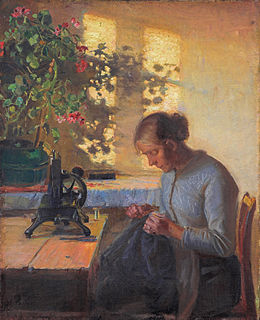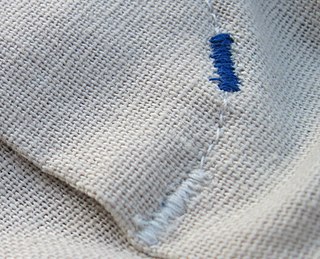Related Research Articles
This is a timeline of Polish history, comprising important legal and territorial changes and political events in Poland and its predecessor states. To read about the background to these events, see History of Poland. See also the list of Polish monarchs and list of prime ministers of Poland.

Sewing is the craft of fastening or attaching objects using stitches made with a sewing needle and thread. Sewing is one of the oldest of the textile arts, arising in the Paleolithic era. Before the invention of spinning yarn or weaving fabric, archaeologists believe Stone Age people across Europe and Asia sewed fur and leather clothing using bone, antler or ivory sewing-needles and "thread" made of various animal body parts including sinew, catgut, and veins.

Da Afghanistan Bank is the central bank of Afghanistan. It regulates all banking and money handling operations in Afghanistan. The bank currently has 46 branches throughout the country, with five of these situated in Kabul, where the headquarters is also based.

Darning is a sewing technique for repairing holes or worn areas in fabric or knitting using needle and thread alone. It is often done by hand, but it is also possible to darn with a sewing machine. Hand darning employs the darning stitch, a simple running stitch in which the thread is "woven" in rows along the grain of the fabric, with the stitcher reversing direction at the end of each row, and then filling in the framework thus created, as if weaving. Darning is a traditional method for repairing fabric damage or holes that do not run along a seam, and where patching is impractical or would create discomfort for the wearer, such as on the heel of a sock.

Mary Brooks Picken was an American author of 96 books on needlework, sewing, and textile arts. Her Fashion Dictionary, published by Funk and Wagnalls in 1957, is the first dictionary in the English language to be published by a woman.

The Central Bank of the Democratic People's Republic of Korea is North Korea's central bank. Established on December 6, 1947, it issues the North Korean wŏn. The Bank is subordinated to the Cabinet of North Korea. Since 2014, the president of the bank is Kim Chon-gyun. He was preceded by Paek Ryong-chon since 2011.

The vice president of the Islamic Republic of Afghanistan was the second highest political position attainable in the Islamic Republic of Afghanistan. The vice presidents were elected on the same ticket as the president. A presidential candidate was responsible for nominating two candidates for vice president before the election.

In sewing, bar tack, also written bar-tack or bartack, refers to a series of stitches used to reinforce areas of a garment that may be subject to stress or additional wear. Typical areas for bar tack stitches include pocket openings, buttonholes, belt loops, the bottom of a fly opening, tucks, pleats and the corners of collars. Bar tacks may be sewn by hand, using whip stitches, or by machine, using zigzag stitches. The process for sewing a bar tack is essentially to sew several long, narrowly-spaced stitches along the line of the bar that will be formed, followed by short stitches made perpendicular to the long stitches, through the fabric and over the bar. The bar commonly varies between 1⁄16 to 1⁄8 inch in width and 1⁄4 to 3⁄8 inch in length. In some garments, such as jeans, the bar tack will be sewn in a contrasting color.
Mary Elizabeth Mann, née Rackham, was a celebrated English novelist in the 1890s and early 1900s. She also wrote short stories, primarily on themes of poverty and rural English life. As an author she was commonly known as Mary E. Mann.
Sewing is the craft of fastening or attaching objects using stitches made with needle and thread. Sewing is one of the oldest of the textile arts, arising in the Paleolithic Era. Although usually associated with clothing and household linens, sewing is used in a variety of crafts and industries, including shoemaking, upholstery, sailmaking, bookbinding and the manufacturing of some kinds of sporting goods. Sewing is the fundamental process underlying a variety of textile arts and crafts, including embroidery, tapestry, quilting, appliqué and patchwork.

The Northern Railroad was a U.S. railroad in central New Hampshire. Originally opened from Concord to West Lebanon in 1847, the Northern Railroad become part of the Boston and Maine system by 1890.
The Ministry of Planning and Finance administers Burma's monetary, fiscal policies and national planning.
Stoating, sometimes written stoting or stotting, is a type of stitching made to join two pieces of woven material, with raw edges placed together, such that the resulting stitches are not visible from the right side of the cloth. Stoating is accomplished by passing the needle only halfway through the pieces of material to be stoated, using a very fine needle and thread, such as silk, or even hair. Stitches would be drawn from side to side across the opening to be sewn closed, in a pattern resembling a zig-zag or the rungs of a ladder. Stoating may be used on heavier fabrics, such as felt and some types of tweed, or fabrics that will not fray easily. Stoating would also be used in place of seaming on heavy furs. When completed, the join should lie flat and not be visible from the right side of the fabric.
The following is a timeline of the history of the city of Matanzas, Cuba.

Sierra Leone Ministry of Finance is a ministerial department of the Government of Sierra Leone, and is in charge of managing the revenue and finances of the Sierra Leone government. The ministry implements the Sierra Leone government economic policies and public financial management. The ministry advises the President of Sierra Leone on economic issues. The headquarter of the Sierra Leone Ministry Of Finance is located on George Street in Freetown, Sierra Leone.

Minister of Economy of Fiji is heading the ministry of economy in Fiji.

Minister of Finance, Trade, Investment and Economic Planning of Seychelles is a cabinet minister in charge of the Ministry for Finance of Seychelles, responsible for public finances of the country. The ministry is located in Central Bank Building in Victoria.
References
- ↑ Rathvon, S. S. (September 1901). "Technical Terms of Tailoring". The American Tailor and Cutter. New York: Jno. J. Mitchell Co. 23 (3): 70. Retrieved February 7, 2016– via Google Books.

- ↑ The Boy's Book of Trades and the Tools Used in Them. London: Routledge. 1866. pp. 219–220. hdl:2027/uiuc.1758057_001 . Retrieved February 7, 2016– via HathiTrust.

- ↑ Scott, Clarice L. (1944). Make-overs from Coats and Suits. Washington, D.C.: United States Department of Agriculture. p. 16. Retrieved February 7, 2016– via Google Books.

- ↑ Ryan, Mildred Graves (1954). Thrift with a Needle: The Complete Book of Mending. New York: Charles Scribner's Sons. pp. 23–24. hdl:2027/coo.31924003594474 . Retrieved February 7, 2016– via HathiTrust.
